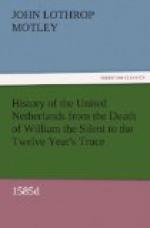The window was instantly thrown open, and the decision publicly announced. The populace, wild with delight, rushed through the streets, tearing down the arms of the Duke of Anjou, which had remained above the public edifices since the period of that personage’s temporary residence in the Netherlands, and substituting, with wonderful celerity, the escutcheon of Philip the Second. Thus suddenly could an Antwerp mob pass from democratic insolence to intense loyalty.
The articles, on the whole, were as liberal as could have been expected. The only hope for Antwerp and for a great commonwealth of all the Netherlands was in holding out, even to the last gasp, until England and Holland, now united, had time to relieve the city. This was, unquestionably, possible. Had Antwerp possessed the spirit of Leyden, had William of Orange been alive, that Spanish escutcheon, now raised with such indecent haste, might have never been seen again on the outside wall of any Netherland edifice. Belgium would have become at once a constituent portion of a great independent national realm, instead of languishing until our own century, the dependency of a distant and a foreign metropolis. Nevertheless, as the Antwerpers were not disposed to make themselves martyrs, it was something that they escaped the nameless horrors which had often alighted upon cities subjected to an enraged soldiery. It redounds to the eternal honour of Alexander Farnese—when the fate of Naarden and Haarlem and Maestricht, in the days of Alva, and of Antwerp itself in the horrible “Spanish fury,” is remembered—that there were no scenes of violence and outrage in the populous and wealthy city, which was at length at his mercy after having defied him so long.
Civil and religious liberty were trampled in the dust, commerce and manufactures were destroyed, the most valuable portion of the citizens sent into hopeless exile, but the remaining inhabitants were not butchered in cold blood.




